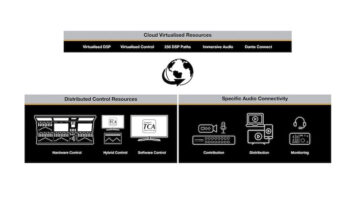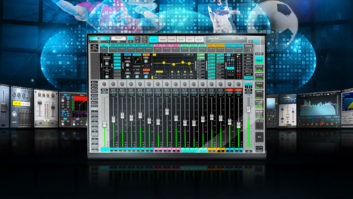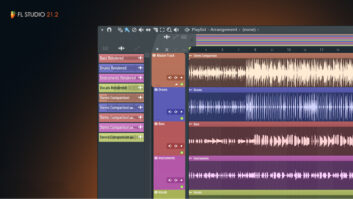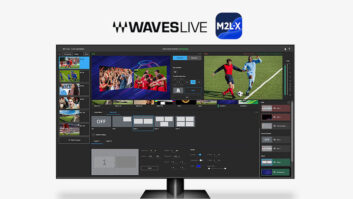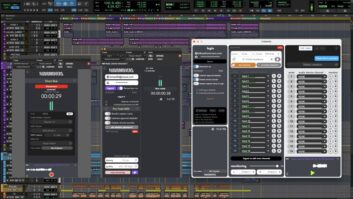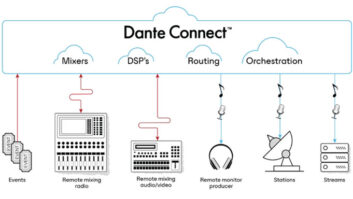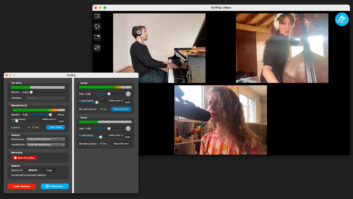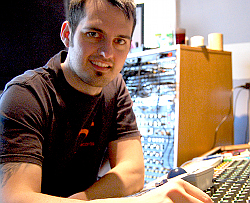
It’s more than just a buzzword. Use of what is colloquially known as “the cloud” as a resource in producing audio seems to increase as its economic and practical benefits become more obvious to engineers, producers and musicians. It’s changing how people share information and collaborate on projects large and small, and we’re just beginning to realize the enormous potential of what really is a new way of working.
On its most basic level, “the cloud” is a metaphor for the way independent computers can be networked on the Internet so files can be conveniently viewed and worked on by multiple users, utilizing third-party servers and mirror sites as neutral storage and retrieval locales for exchanging and updating information. Though “the cloud,” as a term, has only been in vogue for the past couple of years, the concept is not new. For instance, since 2003, YouSendIt has provided a secure medium for users to send and receive digital files of varying sizes, bypassing conventional email. What are relatively new, however, are Web-based file-synchronization and storage services such as Dropbox, Box.net, ZumoDrive and others, which facilitate much more complex means of networking.
Producer/mixer Robert Venable uses “the cloud” for file management and distribution of music files.
IN THE CLOUD
Nashville producer/mixer Robert Venable says, “The majority of the time, I’m using [the cloud] for file management or distribution. I can upload MP3s, WAVs, lyric sheets, song samples, my song demo reel, and distribute those links to those I think might benefit from them. I got hired to produce a record for a female pop singer from Switzerland. I’m based in Nashville and the label flew me to L.A. to do a pre-pro and writing session with her for a week. We met at a studio with some label people and writers, and I took the lyrics that she had sent me a few weeks back, put them in my Google Docs folder in the cloud, and I brought my iPad and MacBook, and the others brought their laptops. In the writing session, there were two or three writers, two label people, the artist and her friend, myself and an assistant engineer, so we could demo the songs. We all shared the same Google Docs file, which was hosted online. We were on a network and we were all able to view changes in real time as we made them to the lyrics and production notes.
“We’d track a vocal melody we liked on a synth and we’d quickly record it, and we uploaded it to my Dropbox folder—everyone on this project had access to a shared folder with a password. We also had my session guys in Nashville tracking strings and guitar melodies over these synth loops I’d produced, and they’d send them back that night so we could all pull them down from the same Dropbox folder and talk about them and send the notes back via Google Docs. Same with mixes: I send roughs back and forth between the artist and the labels and management all the time and get their comments, and I’ve had engineers send files to me for final mixes.
“I can also use my iPhone or iPad to access WAVs or MP3 files or lyrics in my Dropbox. So if I’m driving or flying somewhere, or wherever I have Wi-Fi or cell phone service, I can pull them off onto my phone and put headphones on and take a listen—let it buffer for a few minutes on a cell phone and you’re good. I actually did that with five mixes in the airport yesterday on a two-hour layover in Houston. I listened, and said [to the client], ‘Hey, I’m listening on earphones—not exactly ideal, but here are a few things I hear already.’”

Sherlock Tones used Dropbox to send files back and forth between bandmembers and audio production crew.
TONES, SHERLOCK TONES
Dropbox was also an essential tool in helping electro pop/hip-hop group Sherlock Tones create their new album, LEO (“Love Every Opportunity”) simultaneously in Atlanta, where principal producer/musician Steven Vasiliou lives and works, and the San Francisco Bay Area, where vocalist Khattab McIntosh, keyboardist Elliot Peltzman, mix engineer Chris Fletcher and producer Rei Tracks reside.
“The big benefit is that you can treat the files as if it’s just another folder on your computer,” Tracks says. “We’ll literally place sessions in our Dropbox folder on our computer and work on it. When you’re all done, there’s no need to take any other additional steps because everything automatically gets uploaded to your Dropbox instantly. So you can work on the session, hit the Save button, close it up and walk away, and as long as your computer is online, it’s going to upload. It’s almost like we’re in the same studio working on the sessions.”
“The musical idea will be from me, then I might send it over to Elliot to add keys,” Vasiliou notes. “I don’t need to be with the other players to come up with the song concepts, and then when the music is together, the vocalists have setups at their houses. Khattab has a Pro Tools rig, so I’ll upload the file, he’ll record his vocals right in the Dropbox. I’ll go in and clean it up, then we’ll email Fletch [mixer Chris Fletcher] to let him know they’re ready for mixing. He can open the session on his Pro Tools rig, and then he’ll send us back a WAV stereo file; he doesn’t need to send the whole session back.”
The last song on the album, “My Sister Remix,” took an even more circuitous route to completion, Vasiliou says. “That was a track that Khattab and I had originally recorded and Rei went in to remix it.” Rei Tracks adds, “Once Steve uploaded the original session, I worked on it directly from Dropbox and started remixing it, and then Steve would go in every now and then and make his changes. Then we gave Dropbox folder access to a mixer in Florida—he goes by ‘X144’—and he mixed it directly from the folder.” Vasiliou is in charge of the master Pro Tools sessions.
“This has really allowed me to work with people all over,” Vasiliou notes. “I have a vocalist in Portland I work with and one in Los Angeles, and it’s made the whole process a lot easier.”

Iron & Wine worked with indie producer Brian Deck for their latest, Kiss Each Other Clean.
OLD NEW SCHOOL
Brian Deck, the much-in-demand Chicago-based indie producer who has worked on the last several Iron & Wine (Sam Beam) albums, says, “Depending on the level of audiophile that I’m working with, I’m actually pretty happy to be sending mixes as MP3s, usually just in email. If the MP3 is too big for somebody’s inbox, I’ll use YouSendIt. I ask them to live with it for a day and get me some notes, we’ll talk about it a little on the phone and then I get them a revision, and in most instances we’re 98 percent of the way there.”
In the case of the latest album from Iron & Wine, Kiss Each Other Clean, the pregnancy of Beam’s wife prevented him from going to Chicago for the in-the-box mixing sessions so Deck used YouSendIt to have the artist check the mixes. “I’ll text them right after I send it and let them know it’s waiting for them, and then there’s always something else I can work on while I’m waiting for their comments,” Deck says. “It’s the beauty of digital recall.”
Do the sonic limitations of MP3 affect the sort of mix decisions that are made? “Not usually,” Deck says. “You lose a measure of three-dimensionality, which is hard to put your finger on in the first place. I think you also lose a small measure of stereo imaging. But I find that when I’m discussing this with people and I’ve made fairly small corrections from one mix to the next, in terms of imaging, the astute listener can hear it—especially when they’re listening on ear buds, which more and more people find to be a relevant mix reference. And MP3 is also part of so many people’s listening experience.”

Nile Rodgers’ keyboardist/engineer/right-hand man for the past 23 years, Richard Hilton, has been cloud denizens for some time now.
LE NUAGE C’EST CHIC
“Nuage” is French for “cloud” and “Chic” is, in this case, English for one of the great R&B/dance bands this country produced in the late-20th century—and which is still going strong in the second decade of the 21st under the leadership of the joyous funktician Nile Rodgers. Rodgers has a third-floor studio in his beautiful home in Westport, Conn., and he and his keyboardist/engineer/right-hand man for the past 23 years, Richard Hilton, have been cloud denizens for some time now.
Hilton notes, “With respect to files like mixes—split-stereo WAV files at various sample rates—those always get delivered via some form of FTP or cloud. YouSendIt is very popular. We just finished a mix that was a collaboration between Chic and Kool & The Gang, and it went back and forth numerous times over the Internet as Pro Tools sessions. It started with them, it came to us, we kind of re-wrote it, sent it back to them, they worked on it for a few months, it came back to me and I ended up having to add to and clean up some things.
“Coming in my direction, Kool & The Gang would use YouSendIt. I tend to use, up to the limits of my storage, MobileMe—Apple’s cloud thing. The cloud-sharing aspects are really good and I use it all the time in that kind of work, and for distributing materials to other [Chic] bandmembers. A good example is just yesterday, a singer whom we’ve worked with many times before is coming with us on this tour of Japan, and she hasn’t heard the show in probably two or three years, and a lot of things have changed. So there were a number of materials I needed to make available to her so she could do the research she needed to show up for rehearsals prepared. They were already up there in my MobileMe files so I could send her links, the downloads come immediately, they unpack immediately, and it’s very, very easy at the user end.
“MobileMe also offers a lot of other features related to synchronizing all of your Mac-related or subscribed hardware to a single server. You can sync all sorts of cool stuff either automatically or on demand, and you can do screen sharing easily without somebody at the remote end. So I can sit here at home and look at my computer at Nile’s studio and do whatever I want on it basically.”
Much as he loves working in the Apple cloud, Hilton is aware that the new methodologies have come with a price: “We signed up for a business that was very social, where people would get together in rooms and make music, and other people would be in the control room recording them. We’d all have lunch together and it was a very social business. We now work in an extremely isolated business, so if there’s a downside it’s that the cloud-computing aspect facilitates something that’s a symptomatic byproduct of what is the problem, which is that we no longer work in a social business.”

